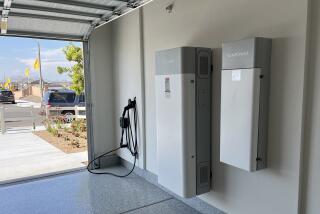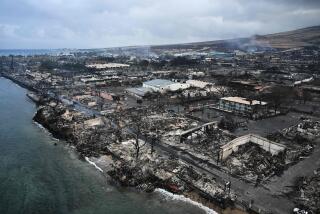Gas Fireplace Is Becoming a Hotter Item : Comforts: Cleanliness, ease of use fuel growing popularity. Big firms like Lennox enter market that includes O.C. makers.
- Share via
When Christopher Tower rebuilds his burned-out Laguna Beach home later this year, he plans to incorporate a beautiful wood-burning fireplace to complement the stunning Pacific Ocean view from his new living room.
But in a nearby bedroom, Tower is forsaking the allure of a wood-burner for a unit that burns natural gas. The second fireplace, Tower said, “is mainly for ambience . . . a gas fireplace is easy to use and it’s clean.”
Driven largely by ease of use, sales of gas hearth appliances are steadily increasing. In 1989, only 5% of factory-built fireplaces installed in U.S. homes burned gas. Now, gas hearth appliances account for 26% of all factory-built fireplaces.
In about five years, gas units will probably account for about half of all factory-built fireplaces installed in the United States, according to industry observers. Retailers also report strong demand for relatively inexpensive gas log sets and gas fireplace inserts, devices that convert wood-burning fireplaces to burn gas.
The move toward gas appliances reverses a trend that began in the 1970s, when jittery consumers responded to a string of energy shortfalls by chopping and burning cordwood.
One dramatic measure of wood’s shrinking popularity: the U.S. Environmental Protection Agency believes that consumers in cold-weather regions were buying 1 million energy-efficient wood stoves annually during the early 1980s. But in 1993, retailers sold just 130,000 wood-burning stoves.
Sales of gas hearth appliances are fueled in large part by the high cost of wood--a cord of oak costs at least $300 in Orange County--along with growing environmental concerns. The high cost of fuel makes wood-burning prohibitive, gas proponents said, especially in Southern California, where fireplaces typically are used as decorative, rather than heating, appliances.
But simple demographics also play a role.
“We’re all aging,” said Hearth Assn. spokesman John Crouch. “Families that gathered and chopped their own heat in the form of firewood are finding that it just isn’t as sexy an idea as it used to be.”
Gas hearth appliances are especially popular in upstairs bedrooms and rooms that are decorated in light, airy colors. “You don’t have to schlep wood up and ashes down and get everything dirty,” said American Gas Assn. spokeswoman Julie Stewart.
Gas units are getting a strong push from the nation’s natural gas utilities, some of which are offering rebates to customers who buy gas hearth appliances. The Southern California Gas Co. does not offer rebates but this past winter it did sponsor highway billboards promoting the use of gas logs.
In some Western states, gas fireplace sales are also being driven by tough emission-control regulations akin to federal Environmental Protection Agency regulations that govern wood stoves.
Two years ago, Las Vegas, one of the nation’s fastest-growing cities, responded to a growing haze problem over the city by regulating emissions from wood-burning fireplaces. The regulations, which cover only new construction, mandate the use of catalytic converters or secondary combustion chambers that cost as much as $1,000.
“The Steve Wynns, Andre Agassis and resort moguls are still putting in wood-burning units but the standard subdivision home has a gas-burning unit,” said Michael Naylor, director of the Air Pollution Control Division in Clark County, which encompasses Las Vegas.
Las Vegas residents are taking the regulations in stride, Naylor said, because, as in Southern California, a fireplace is “mainly an entertainment device” that is seldom used as a primary heating source.
But manufacturers are using technological advances to meet energy-efficiency demands of consumers in cold-weather climates.
Santa Ana-based Fireplace Manufacturers Inc., for example, continues to sell most of its units in warm climates. But the company is selling its gas fireplace units in Canada and Norway and hopes to enter the Chinese market through a joint venture with a natural gas company in Shanghai.
Consumer demand for gas hearth appliances has sparked interest from some of the nation’s largest heating, ventilation and air-conditioning manufacturers. Traditionally, the larger companies have ignored the market, which has long been dominated by smaller, regional competitors like Fireplace Manufacturers, Superior Fireplace Inc. in Fullerton and Robert H. Peterson Co. in the City of Industry.
Earlier this month, Dallas-based Lennox Industries Inc. introduced its first gas-fired fireplace. The unit, which initially will be sold in Canada, will be marketed in the United States in 1995. Industry sources said that Rheem Manufacturing Co. and Carrier Corp. are also developing gas fireplace units.
Manufacturers credit increasing consumer demand to technological advances and crisp designs that result in attractive units that provide sufficient heat and are relatively inexpensive to operate.
It’s still more expensive for builders to install gas fireplaces in new homes than to incorporate gas-fired appliances, said Judy Bentley, gas product manager for Superior Fireplace.
“You’re dealing with gas valves, burners, the guts of the gas-fired unit,” Bentley said. “But builders know that people want gas units. Wood-fired fireplaces are becoming a pain in the butt for many people.”
Gas-fired appliance manufacturers are using technology to develop products that provide higher efficiencies than wood-burning units.
“Fireplaces aren’t just boxes with chimneys sticking out of them anymore,” said John Hornsby, chief operating officer of Fireplace Manufacturers, which next year for the first time will offer more gas models than traditional wood-burning units. “Consumers increasingly are moving toward the gas fireplaces.”
Its newest models offer highly efficient burners that don’t require expensive chimneys. Some units can be vented through walls; others, while not yet legal in California, are vent-free and can be installed in the middle of a room.
Fireplace Manufacturers’ units incorporate thermostats and hand-held, remote-control devices that turn flames on and off. Units without vents now on the market in some parts of the country include sensors that automatically shut down burners if the oxygen levels in a room fall below safe levels.
The industry has also devised a way to fix the age-old consumer complaint that a gas-fired unit’s blue flame pales in comparison to the golden warmth of a wood fire. Researchers at the American Gas Assn.’s research and development facility in Cleveland developed a technology that lets gas-fired units mimic the yellow-gold flame--if not the distinctive odor--of a wood-burning fireplace.
Robert H. Peterson Co., which has been manufacturing relatively inexpensive gas log units for 45 years, also is using the new, golden-flame technology and remote-control devices to bolster sales.
“If installed properly, our set will look like wood burning in a fireplace,” said Maurice Boekeloo, Peterson’s vice president of marketing. “We think one of our (sets) burning in the fireplace is going to give you the right environment.”
But, if ambience alone isn’t sufficient, Boekeloo quickly falls back on ease of use. “There’s no cleaning, no ashes, no hassle,” Boekeloo said. “When it’s time to leave you simply turn it off.”
More to Read
Inside the business of entertainment
The Wide Shot brings you news, analysis and insights on everything from streaming wars to production — and what it all means for the future.
You may occasionally receive promotional content from the Los Angeles Times.










